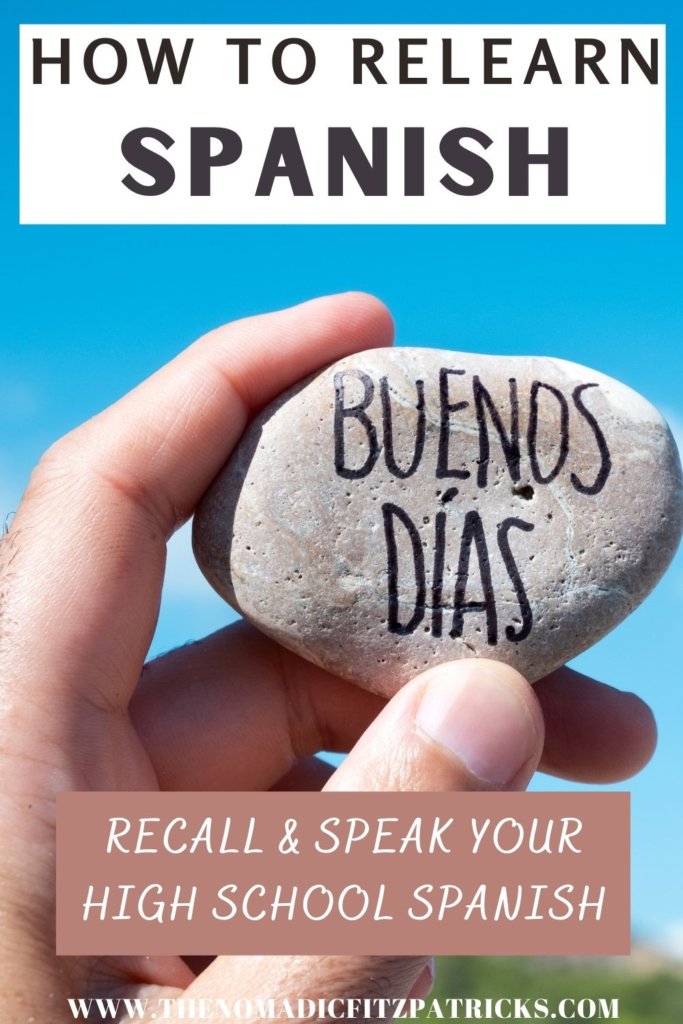How do you relearn the Spanish language after years of not practicing?
This blog post will show you five ways to do just that!
You’re probably reading this because you learned Spanish in the past and maybe need a little help. After years of learning the language, you’re flabbergasted that you can’t even put together a proper sentence to order food in a Mexican restaurant.
As a high school Spanish teacher & tutor for almost a decade, I’ve spent hundreds of hours writing lesson plans, reflecting, and figuring out what tricks, practices, and concepts work best to not only understand the Spanish language but to be able to use it in real life. Conjugating verbs are great, don’t get me wrong, but no one on the streets of Buenos Aires will approach you with a mate gourd in hand, asking,
“Excuse me, could you please conjugate the present-tense forms of the verb bailar, including the vosotros form that is only used in Spain?”
Not terribly likely.
You’re more likely going to need to ask for directions, order food (or explain a dietary restriction, like me!), or say hello to a new friend.
If you’re frustrated because you remember learning Spanish but have no idea how to actually apply that knowledge in the real world, this is for you! In this post, I will focus on five proven methods that will help you relearn the Spanish language.
How to Relearn the Spanish Language

Note: These skills could also be applicable for rekindling any world language knowledge, and not only Spanish. Due to the fact that I am a Spanish teacher and speak Spanish, this article will focus mostly on resources for Spanish. Feel free to apply it to any other language you want to practice and relearn.
Benefits & How You May Have Learned Spanish
The benefits of speaking a second language are endless - especially if that language is Spanish.
Spanish is one of the most common languages spoken worldwide and the second most popular language here in the United States. Students as young as elementary school begin learning world languages, which can continue into middle school and then high school. Most colleges require two to three years of world language courses for admittance.
Once the college requirement is complete, many students move on to either planning their career, university path, or preparing for the military. After years of learning a language in detail, they stop completely. All of that knowledge and skill, without practice, can weaken or even disappear completely.
Many of us were taught Spanish in school in a way that was focused primarily on grammar. It was drilled into our heads along with lists and lists of vocabulary words to memorize each week. While the grammatical structures are important, and vocabulary is useful, all of that knowledge means nothing unless we can actually speak Spanish in the real world.
Remembering our knowledge of Spanish is good.
APPLYING that knowledge is even better.
Get reacquainted with Spanish vocabulary.
Vocabulary is an ever-growing list. I am still learning new words in the English language - and it’s my native tongue. There will always be new words to learn.
On a document or in a notebook, see what vocabulary words you can remember in Spanish. You can divide them into topics, such as “Greetings”, “Food”, “Places”, “Family” or even “Descriptions”. Once you have added all the ones you can remember, begin thinking about the words you feel are most common in conversation, and those you would need to use.
Become familiar with these words once more. Use a resource to help you add to your list - such as SpanishDictionary. Review them, practice them, and make flashcards with them. There are applications to do this - websites like Quizlet have vocabulary words in lists already made for you to practice right away. Your brain will need repeated, rote memorization of common words and phrases to relearn the Spanish language with success - especially in the beginning.
In your home, work, gym, or even at the grocery store - try and see how many things you can say in Spanish. This is the perfect way to practice your vocabulary. At the gym, if you see a man, say to yourself “un hombre”. At the grocery store checkout when you see an avocado, think “un aguacate”. Use your everyday life and routines to recall as many words as you can and practice that recall on a regular basis.
Remembering the vocabulary words is the first step toward relearning the Spanish language.
Practice making basic sentences in Spanish.
An application that I use in my own classroom (and at home) to practice sentence structure is Duolingo.
Duolingo is one of the most popular applications & websites to learn a second language. While it’s not perfect, it provides the basic structure for making sentences in Spanish, and incorporates them through the 4 strands of communication - reading, writing, listening, and speaking. And - it’s free!
Duolingo is designed like a game. Lessons are short, easy to follow, and interactive. My students are stronger in grammar and in speaking thanks to their weekly Duolingo assignments. It’s an easy way to practice your reacquainted vocabulary and begin using those words with simple verbs in sentences.
You can also try Babbel, FluentU, or StudySpanish for more practice on grammatical structures, sentences, and basic conversation. Think about preparing sentences for common topics or situations, such as asking for directions, ordering food, making introductions, and talking about family/friends.
OR to go even further: hire a private language tutor from Preply!
Retrain your ear to listen in the Spanish language.
Duolingo is one way to begin listening to the Spanish language once more, but it isn’t enough. You need to LISTEN to the language, and you need to hear a LOT of it in order to begin understanding what people are saying.
Your ear needs to develop to not only pick out a single word (like “pollo” at a Dominican restaurant) but to be able to hear the entire sentence. Within sentences, you will need to be able to hear accents, colloquialisms, jokes, conjunctions, and more.
The same complexities we have in English also exist in Spanish. We’ve just had years of training our ears to understand the ones in English - which is why those are so easy. To relearn the Spanish language, you must retrain your ear to listen in a second language.
It will take time for your ear to develop to hear Spanish and understand it. Don’t be frustrated if you can only pick out a word or two at first. The more you can expose yourself to the language, the quicker you’ll have those OMG I UNDERSTOOD THAT moments!
Here are some of my students’ favorite methods for auditory input:
- Listen to the Spanish channels on the radio.
- Listen to Hispanic music on the radio or YouTube. Download albums from Shakira, Daddy Yankee, Aventura, or Enrique Iglesias.
- Pick a movie you know every line to and watch it in Spanish - without subtitles. See if you can understand what’s going on, and write down the words you hear!
- Turn on the telenovelas you see on Daytime TV - the drama is laughable, but the language you hear is important.
- Get together with friends who speak Spanish (either online or in-person) and ask them to practice with you!
- Hire a tutor who is a native speaker to practice speaking together!
Auditory input is necessary, and one of the most important keys to success in speaking Spanish. Listening is crucial! When you can comprehend what a person is saying, your brain begins to understand how to respond back.
For more practice on auditory input, try Yabla, which includes short videos in Spanish and accompanying audio scripts. You watch the video and fill in the blanks from the audio.
Look for comprehensible input in Spanish.
In the teaching scene - the newest buzzword in world languages from the last five years is something called comprehensible input. It means exposing students to the language as much as possible - and not worrying about small grammatical errors.
When I learned Spanish in school, we learned from a textbook. Our exams were focused on making sure every accent mark was perfect and every grammar term was flawless. We rarely had our own conversations! Comprehensible input is the idea of using real-life, meaningful materials to expose students to the language and to practice having actual conversations - mistakes, and all.
Real-life materials are more meaningful and give you an idea of what the language can actually look like. You want to get as MUCH exposure to the language as possible and as much practice as possible - even with a few mistakes.
More auditory input = better-spoken output.
Try picking up a copy of a Spanish magazine the next time you are at the grocery store or Barnes & Noble. Take out children’s books in Spanish and read them out loud - even if you mispronounce words. Pick up a travel brochure for a Spanish-speaking country or one that is translated into Spanish. It’s a great practice to see the words in real-life use and to become comfortable speaking out loud.
For more comprehensible input ideas, check out this resource from a fellow Spanish teacher.
Immerse yourself in Spanish & MAKE mistakes!
Ready for the best way to relearn the Spanish language?
Get out there and SPEAK IT!
Don’t be embarrassed, and be prepared to make mistakes - it’s okay. Like I always said to my students - do the best you can! With practice (like anything), it will become easier. The goal is to try, even if you mess up a few times. One word is still more than zero.
Mistakes can happen, and yes, you will make them. Lots of them. Best prepare yourself for situations like the following:
You and a friend are in Madrid, Spain, on a warm spring day. You see a few fluffy ducklings wading in the river, and want to tell someone about this display of cuteness.
Excited, you exclaim,
“Miran - Los patatitos!”
Unaware of your error, your friend bursts into hysterical laughter.
Patata: potato
Patito: duckling
Patatito: a little potato
You laugh it off and add it to your repertoire of funny stories of learning a second language.
Benny the Irish Polyglot is a language hacking genius - and speaks multiple languages. One of the best ways he gets language practice is by going to malls and public places and approaching others. If they speak a language other than English, he says hello and asks if they can practice. It might seem intimidating, and he makes mistakes, but it’s a great way to get that exposure and auditory input. Benny argues that speaking as early as day 1 makes a big difference.
Traveling is another method that can help you practice the language.
When you are surrounded by the language everywhere you look or listen, it becomes more like second nature and easier to produce. It wasn’t until I lived in Spain that speaking really became easy. Living with a host mother who spoke no English forced me to speak Spanish. After two weeks, I was even thinking in Spanish.
Ten years later, I was nervous our first few days in South America - and afraid I was out of practice. But after two days, that’s all it took to speak Spanish comfortably once more! Immersing yourself in the culture, language, and people that speak Spanish will force your brain to actually practice it!
If traveling to a Spanish-speaking destination isn’t feasible right now, don’t worry. Try these travel tips to save money on your next vacation, and try speaking the language right here at home!
Duolingo has meet-ups for users all over the country. Other travel sites, including Couchsurfing, offer meetups for those interested in speaking another language. You can also check your local library, community college, and town for language meetups. Or, try meeting up online through Google Hangouts, FaceTime, and even Skype!
Remember - more auditory input = more spoken output!
Recap & Final Thoughts To Relearn Spanish
- Reacquaint yourself with the vocabulary.
- Practice sentence structure using an online application like Duolingo.
- Retrain your ear - listen to the language as much as possible.
- Look for comprehensible input.
- Get out there and speak it!
Speaking Spanish can provide so much confidence when traveling. It multiplies the number of people you can communicate with, and it helps keep your brain in tip-top shape. It also teaches you about other cultures, customs, and nationalities. Having Spanish in my back pocket during our round the world trip helped me time and time again - even in countries that don’t speak Spanish!
With the overwhelming number of benefits to speaking a second language - don’t let your studies go to waste. Get back out there and show everyone what you know! With your practice and application of these methods, you can teach others how to use the verb bailar in a sentence rather than just conjugating it.
You can relearn the Spanish language with pride and success.
And if you happen to call the baby ducklings baby potatoes by mistake, you’ll know to never mix up those two words again.
¡Buena Suerte!

Looking for more celiac travel posts?
Avoid these five mistakes when dining out with celiac disease!
Flying somewhere and worried you'll be starving in an airport? Not to worry, this post on flying with celiac disease has you covered!
Do you have celiac AND IBS? I do too. Here's how I manage both when traveling.
Get my gluten-free travel guides to Boston, New York, Madrid, Buenos Aires (plus many more) here!





Comments
No Comments